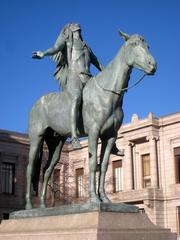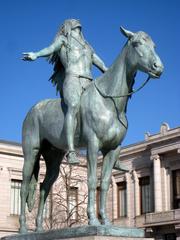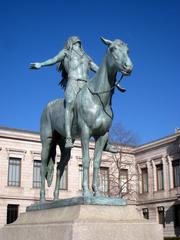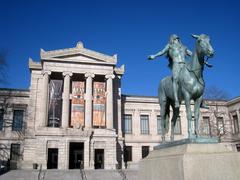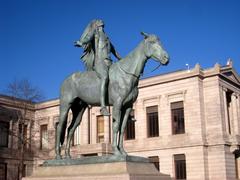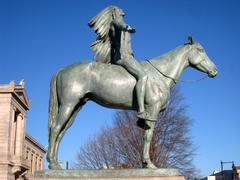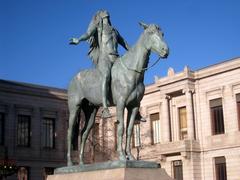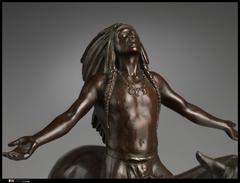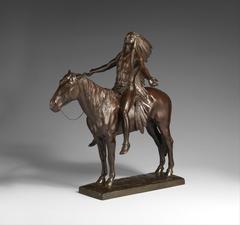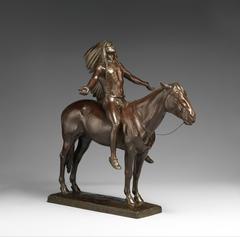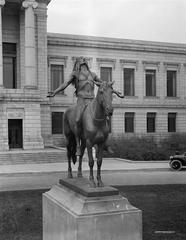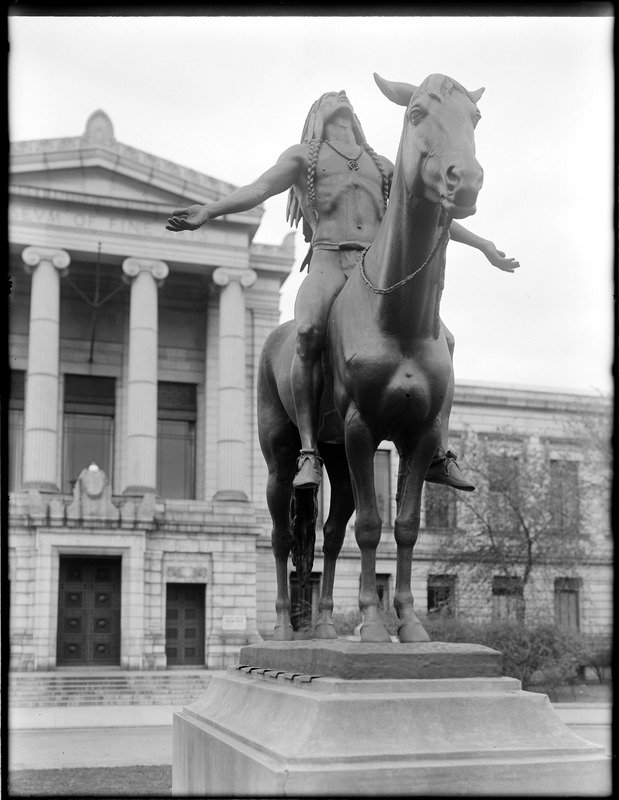
Complete Guide to Visiting “Appeal to the Great Spirit” at Boston’s Museum of Fine Arts
Date: 14/06/2025
Introduction
Standing sentinel at the main entrance of Boston’s Museum of Fine Arts (MFA), Cyrus Edwin Dallin’s “Appeal to the Great Spirit” is a monumental bronze sculpture that captures the imagination and provokes thoughtful dialogue. Since its installation in 1912, this statue has become a symbol of both the city’s artistic landscape and America’s evolving relationship with Indigenous representation.
This comprehensive guide provides everything you need to know to experience “Appeal to the Great Spirit”—including its history, artistic features, significance, practical visitor information, and surrounding cultural attractions. Whether you are a first-time visitor, art lover, or history enthusiast, this resource will help you make the most of your visit and deepen your understanding of this iconic work.
For further details, visit the Museum of Fine Arts Boston official page and consider the Audiala app for immersive audio tours and event updates.
Table of Contents
- Introduction
- Visitor Information: Hours, Tickets, Accessibility, Directions
- History and Artistic Background
- Symbolism and Interpretations
- Community Perspectives and Contemporary Controversies
- Restoration and Conservation
- Guided Tours, Events, and Photography Tips
- Nearby Attractions and Itinerary Ideas
- Frequently Asked Questions
- Additional Resources and Further Reading
- Conclusion
Visitor Information: Hours, Tickets, Accessibility, Directions
Location
- Address: Museum of Fine Arts, 465 Huntington Avenue, Boston, MA 02115
Accessibility
- The sculpture is located outdoors at the main Huntington Avenue entrance and is wheelchair accessible with level pathways and nearby benches.
- Service animals are welcome on the museum grounds.
Visiting Hours
- Statue Access: The statue is outdoors and accessible 24/7, free of charge.
- Museum Hours:
- Tuesday–Sunday: 10:00 AM – 5:00 PM
- Extended hours on Wednesday and Friday until 10:00 PM
- Closed Mondays and major holidays
- Check MFA’s website for seasonal or special closures.
Tickets
- No ticket is needed to view the statue outside.
- Admission is required for entry to the MFA’s galleries and exhibitions.
- Adults: $27
- Seniors: $25
- Students: $10
- Youth under 18: Free
- Purchase tickets on the MFA Tickets page.
Directions and Transportation
- Public Transit: The Museum of Fine Arts stop on the MBTA Green Line E branch is adjacent to the entrance.
- Parking: On-site garage parking is available (limited spaces); neighborhood is pedestrian-friendly.
- Map and Directions: Google Maps
History and Artistic Background
Origins and Creation
Cyrus Edwin Dallin, an American artist raised in Utah with close ties to Native communities, completed “Appeal to the Great Spirit” in 1908. The statue is the culminating piece in his “Epic of the Indian” series, which explores themes of Indigenous experience and spirit. Cast in Paris in 1909, the work was awarded a gold medal at the Paris Salon (Museum of Fine Arts, Boston; Smithsonian American Art Museum).
Installed outside the MFA in 1912, the statue quickly became a lasting symbol of the museum and Boston as a whole.
Symbolism and Interpretations
Artistic Features
- Depiction: A Native American man, anonymous and unarmed, sits atop a muscular horse with arms outstretched, palms open, and head lifted skyward in prayer or supplication.
- Regalia: The figure combines elements from several Plains and Great Basin tribes, reflecting early 20th-century artistic conventions but not strict historical accuracy.
- Expression: The pose evokes themes of hope, humility, dignity, and spiritual connection.
Interpretive Layers
Dallin intended the statue as a tribute to Indigenous dignity and resilience. However, over time, viewers and scholars have highlighted its role in perpetuating the “vanishing race” narrative—a romanticized and problematic trope that suggests the inevitable disappearance of Native peoples (MFA Article).
Community Perspectives and Contemporary Controversies
Indigenous and Community Responses
Reactions to the statue have evolved:
- Early praise, such as from Omaha Nation ethnologist Francis LaFlesche, lauded its dignity (Dallin Museum).
- Recent Indigenous artists and community members have critiqued its role in reinforcing stereotypes and colonial narratives (Boston Globe; MFA Visitor Responses).
Institutional Response and Contemporary Art
The MFA acknowledges the complex legacy of the statue and actively engages with Indigenous voices:
- Commissioning works such as Alan Michelson’s “The Knowledge Keepers” and Elizabeth James Perry’s “Raven Reshapes Boston,” which surround the statue with Native plantings and new narratives (Survive and Thrive Boston).
- Hosting forums, Indigenous Peoples’ Day events, and community-led discussions (Boston.com).
The “Vanishing Race” Trope
Central to ongoing debate is the statue’s link to the myth of the “vanishing race,” a narrative that justified colonial expansion and Indigenous erasure while neglecting Native resilience and cultural continuity (Arts Fuse).
Restoration and Conservation
- The statue’s patina, originally brown, has been returned to its intended green to harmonize with the outdoor environment, following Dallin’s wishes.
- Conservation efforts ensure the sculpture’s longevity and visual impact (Museum of Fine Arts, Boston).
Guided Tours, Events, and Photography Tips
Tours and Programming
- The MFA offers guided tours and educational programs featuring the statue’s history and significance.
- Indigenous Peoples’ Day and other special events include artist talks and community engagement.
Photography
- Lighting is best in early morning or late afternoon.
- Photography is welcome; please do not climb or touch the statue.
Nearby Attractions and Itinerary Ideas
- Isabella Stewart Gardner Museum: Just a 10-minute walk.
- Fenway Park: Home of the Red Sox, 15 minutes on foot.
- Emerald Necklace Parks: Nearby green space for walking and relaxation.
- Northeastern University Campus: Adjacent, with historic architecture.
- Dining: Fenway-Kenmore neighborhood offers numerous cafes and restaurants.
Download the Audiala app for audio tours and updates on events.
Frequently Asked Questions
Q: What are the visiting hours for “Appeal to the Great Spirit”?
A: The statue is accessible 24/7. Museum galleries are open Tuesday–Sunday, 10:00 AM–5:00 PM, with extended hours on Wednesday and Friday.
Q: Is a ticket required to see the statue?
A: No. The statue is outdoors and free to view. Tickets are only required for entry to the MFA galleries.
Q: Is the statue wheelchair accessible?
A: Yes. The area is wheelchair accessible with paved paths and benches nearby.
Q: Can I take photos?
A: Yes, photography is encouraged. Please respect the artwork and do not climb on it or its base.
Q: How do I get there by public transportation?
A: Take the MBTA Green Line E branch to the Museum of Fine Arts stop, right by the entrance.
Q: Are there special events or Indigenous programming?
A: Yes. The MFA hosts regular events, especially around Indigenous Peoples’ Day. Check their special events calendar.
Additional Resources and Further Reading
- Museum of Fine Arts Boston Official Website
- Appeal to the Great Spirit at MFA Boston
- Cyrus Dallin Art Museum
- Smithsonian American Art Museum on “Appeal to the Great Spirit”
- Boston Globe: MFA addresses sculpture controversy
- Survive and Thrive Boston: Indigenous Art Installations
- Audiala Audio Tour App
- Lonely Planet Boston Travel Tips
Conclusion
“Appeal to the Great Spirit” is more than a work of art—it is a living focal point for dialogue about history, identity, and cultural memory in Boston. By visiting, you not only witness Dallin’s sculptural mastery but also participate in ongoing conversations about representation, resilience, and the future of public art. Enhance your visit with guided tours, special events, and digital resources, and explore the broader cultural offerings of the MFA and surrounding Boston landmarks.
For the best experience, plan your visit during museum hours, explore nearby attractions, and use the Audiala app for guided tours and updates. Engage thoughtfully and respectfully with both the statue and its surrounding stories—your journey into Boston’s artistic and historical legacy awaits.


